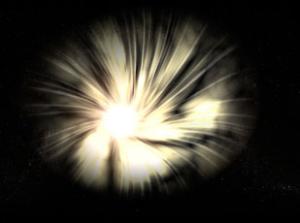
© SPL
Swarms of tiny black holes forged in the big bang may have killed off the universe's first stars by devouring them from within. The digested end-products could then have grown into the colossal black holesMovie Camera now lurking in the centres of galaxies, whose origins have long been a mystery.
Some physicists speculate that minuscule black holes may have been forged in the very dense soup of matter and radiation that prevailed in the first moments of the universe's existence. If so, these might account for at least some of the invisible dark matter that pervades the universe.
Now Cosimo Bambi of the University of Tokyo in Japan and colleagues have shown that these black holes could also have destroyed the universe's first stars by eating them from the inside out.
The first stars are thought to have formed around 200 million years after the big bang, in the centres of the universe's densest dark matter clumps. Stars would have been most likely to ignite there because the dark matter's gravity would have pulled in the gas necessary for them to form.
Bambi's team calculated what would happen if the dark matter was composed of microscopic primordial black holes. They assumed that each black hole would have had about the mass of the dwarf planet Ceres - observations have ruled out much heavier ones as dark matter candidates, while much lighter ones would have quickly evaporated away via quantum effects.
A star forming in the centre of a dense clump of such dark matter would contain about 1 million of these black holes mixed in with its ordinary matter, the team calculates. Their great density would quickly make the holes sink into the star's core and merge.
The resulting larger black hole would consume the star in less than a million years, gaining between 10 and 1000 times the mass of the sun, the team says. Once reaching this size, such black holes could grow even more quickly by sucking in surrounding gas, perhaps turning into the behemoths found at the centres of galaxies, with billions of times the mass of the sun.
So why don't we see this happening in the modern universe? The difference is that most stars now form outside galactic cores. Here primordial black holes should be much rarer, so embryonic stars would be unlikely to encounter one.
"That's why primordial black holes today can't eat up all the stars in our galaxy - there aren't enough of them," says team member Katherine Freese of the University of Michigan in Ann Arbor.
The team's idea is intriguing, says Mitchell Begelman of the University of Colorado in Boulder, but he thinks the big black holes at the centres of galaxies are more likely to be the descendants of million-solar-mass black holes formed by the collapse of gas clouds: "It is easier to grow truly huge black holes quickly if you start with a larger seed."

Reader Comments
to our Newsletter